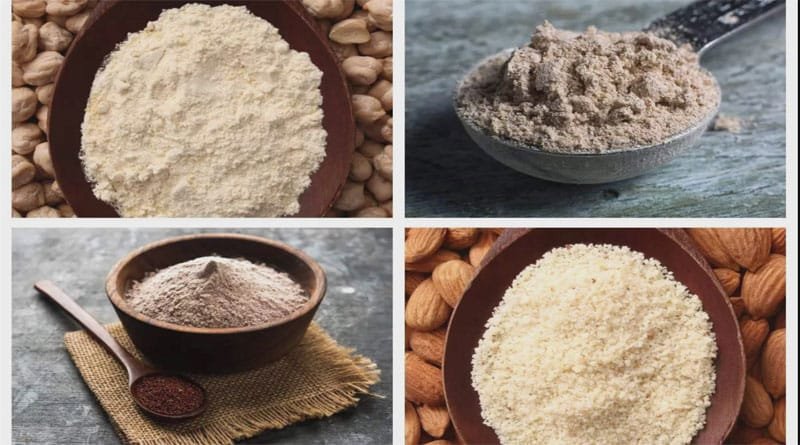Flour Good for Diabetes: 11 Benefits and Uses
Effectively managing diabetes frequently involves making careful dietary decisions, with choosing the appropriate flour being a key consideration.
We will explore the Flour Good for Diabetes, finding ways to stabilize blood sugar levels while still savoring favorite baked goods and meals.
Selecting a suitable flour, such as nutrient-dense almond flour or fiber-rich coconut flour, can significantly enhance diabetes management journey. Rich in protein and beneficial fats, almond flour helps maintain stable blood sugar levels while adding a pleasing nutty taste to your recipes.
Coconut flour, renowned for its high fiber content and low glycemic index, is an excellent choice for those seeking to manage their carbohydrate intake.
Alternatives like chickpea flour, which is rich in protein and fiber, and flaxseed meal, which is renowned for its omega-3 fatty acids and lignans that offer numerous health benefits.
These flours enhance nutrition and expose diverse culinary possibilities, from fluffy pancakes to savory bread. By understanding the unique properties of each flour, you can better tailor your diet to support health and enjoy a diverse, flavorful diet, even while managing diabetes.
Flour Good for Diabetes: Why Flour Choice Matters?
Selecting the correct type of flour can make a world of difference in managing diabetes. Certain flours, due to their low carb content and high fiber, can help stabilize blood sugar levels. Let’s explore flours that are good for diabetes and understand why they are beneficial.
1. Whole Wheat Flour:
Whole wheat flour is a popular alternative to white flour. It contains the entire grain kernel, which means more fiber, vitamins, and minerals. For individuals with diabetes, the fiber content helps slow digestion and prevents blood sugar spikes.
Nutritional Profile: Whole wheat flour boasts a higher nutrient profile compared to its refined counterpart. In addition to its rich fiber content, whole wheat flour provides essential nutrients such as magnesium, zinc, and B vitamins, which are vital for maintaining energy levels, supporting immune function, and promoting overall health.
By choosing whole wheat flour, you can enjoy nutritious options that contribute to a balanced diet and better well-being.
How to Use Whole Wheat Flour: Whole wheat flour is a nutritious option for baking a variety of goods, such as bread, muffins, and pancakes. It adds a rich, nutty flavor and boosts the fiber content of baked items.
Be mindful of the texture, as it can be denser than white flour. To achieve a lighter texture, you can combine whole wheat flour with all-purpose flour. Allow for a slightly longer mixing time when baking with whole wheat flour to ensure better hydration and gluten development.
2. Almond Flour
Almond flour is a fantastic option for people with diabetes. It’s low in carbohydrates and high in fiber and protein, keeping blood sugar levels steady.
Nutritional Breakdown: Almond flour is rich in healthy fats, protein, and vitamin E, making it a powerhouse ingredient for various diets. It contains essential minerals like magnesium and calcium, which support bone health.
Almond flour has a lower glycemic index compared to regular flour, meaning it won’t cause sudden spikes in blood sugar, making it an excellent choice for those managing diabetes.
Practical Uses: Almond flour works well in cookies and cakes and even as breading for meats. Its slightly nutty flavor adds a delicious twist to the recipes. Almond flour is a popular choice in gluten-free baking, providing a moist and tender texture to baked goods. It’s also rich in protein, healthy fats, and vitamins, making it a nutritious alternative to traditional flours.
3. Coconut Flour
Coconut flour is another excellent option for diabetes management. It’s incredibly high in fiber and contains healthy fats.
Health Benefits: Coconut flour can significantly improve digestive health due to its high fiber content, promoting regular bowel movements and preventing constipation. It aids in maintaining stable blood sugar levels, which is particularly beneficial for those with diabetes or insulin resistance.
The versatile flour is also gluten-free, making it an excellent option for individuals with gluten sensitivities or celiac disease. Its mild, slightly sweet flavor adds a unique twist to various recipes, enhancing both taste and nutritional value.
Cooking Tips: When using coconut flour, remember that it absorbs a lot of moisture. This means you’ll need to adjust the liquid content in recipes to avoid dryness significantly. Coconut flour is highly absorbent, so even a tiny amount can thicken batters and doughs.
To achieve the desired consistency, you may need to incorporate additional eggs or other liquids. It’s a good idea to let the mixture sit for a few minutes after mixing to allow the flour to absorb the moisture before baking or cooking thoroughly.
4. Flaxseed Meal
Flaxseed meal is packed with omega-3 fatty acids, fiber, and lignans, which have numerous health benefits, including blood sugar regulation.
Nutritional Content: Flaxseed meal is low in carbs and high in both soluble and insoluble fiber. This combination helps in slowing down the absorption of glucose, making it an excellent choice for maintaining stable blood sugar levels.
Incorporating Flaxseed Meal: You can add flaxseed meal to smoothies for an extra boost of nutrients, sprinkle it on oatmeal for added texture and fiber, or use it as an egg substitute in baking by mixing one tablespoon of flaxseed meal with three tablespoons of water. It enhances nutritional value and caters to vegan and egg-free diets.
5. Chickpea Flour
Chickpea flour is made from ground chickpeas and is an excellent source of protein and fiber.
Benefits for Blood Sugar: The high fiber and protein content in chickpea flour helps manage blood sugar levels by slowing down digestion and the release of glucose into the bloodstream. It can lead to stable blood sugar levels, preventing spikes and crashes that are often associated with refined carbohydrates.
The presence of certain nutrients in chickpea flour supports overall metabolic health, making it a valuable addition to a balanced diet.
Culinary Uses: Chickpea flour is ideal for making flatbreads and savory pancakes and as a thickening agent for soups and stews. Its nutty flavor and high protein content make it a versatile ingredient in many gluten-free recipes.
At the same time, its binding properties are perfect for creating crisp and flavorful coatings for fried foods.
6. Oat Flour: Heart healthy and Diabetes Friendly
Oat flour is made by grinding whole oats. It’s rich in beta-glucan, a type of soluble fiber that can help regulate blood sugar levels.
Nutritional Advantages: Oat flour is rich in essential vitamins, minerals, and antioxidants that contribute to overall health. It provides vital nutrients such as vitamin B, iron, magnesium, and fiber, which support the immune system, improve digestion, and help maintain steady energy levels. Including oat flour in your diet can promote heart health and aid in weight management.
Usage Tips: You can use oat flour in baking or as a thickener for sauces and gravies. Its subtle taste harmonizes effortlessly with a variety of ingredients. In baking, it can be substituted for a portion of wheat flour to add a subtle nutty taste and boost the nutritional value.
When used as a thickener, it enhances the texture and adds a bit of fiber to your dishes. Experiment with oat flour in pancakes, muffins, and even homemade bread for a healthier twist.

7. Buckwheat Flour: Discovering Buckwheat Flour
Although its name might suggest otherwise, buckwheat is free of gluten and unrelated to wheat. It is rich in fiber and boasts a low glycemic index.
Health Benefits: Buckwheat flour is known for its anti-inflammatory properties and its ability to improve heart health. Rich in antioxidants, fiber, and essential nutrients, it can help reduce cholesterol levels, manage blood sugar, and support overall digestive health. Incorporating buckwheat flour into your diet is a great way to enhance nutritional intake while promoting overall well-being.
Cooking Applications: Buckwheat flour can be used to make a variety of delicious dishes, including pancakes, noodles, and gluten-free bread. It adds a unique, nutty flavor and is a nutritious alternative to traditional flours. You can also use it in baking, for making muffins and cookies, and even as a thickener in soups and sauces.
8. Quinoa Flour: The Ancient Grain
Quinoa flour is made from finely ground quinoa seeds. It is a complete protein source containing all nine essential amino acids.
Nutritional Highlights: Quinoa flour is high in fiber, protein, and beneficial antioxidants, making it an excellent choice for diabetes management.
It also contains essential amino acids that support muscle repair and overall health. Its low glycemic index helps regulate blood sugar levels, making it an excellent option for those looking to maintain a balanced diet.
Recipe Ideas: Use quinoa flour in baking, especially in recipes that require a lighter texture, like cakes and pastries. Quinoa flour adds a delicate texture and boosts the nutritional profile of your baked goods with protein and fiber. Try it in muffins, pancakes, and even cookies for a healthier twist!
9. Psyllium Husk Powder: Magic of Psyllium Husk Powder
Psyllium husk powder originates from the seeds of the Plantago ovata species.
Impact on Blood Sugar: Psyllium husk helps to slow the absorption of sugar, making it beneficial for those with diabetes. By forming a gel-like substance in the gut, psyllium husk can moderate the rise in blood glucose levels after meals, thereby aiding in better blood sugar management.
It makes it a valuable addition to the diet for individuals looking to control their diabetes or prevent spikes in blood sugar.
How to Use: You can add psyllium husk powder to smoothies for an extra boost of fiber, incorporate it into baked goods like muffins or bread to enhance their nutritional value or take it as a supplement mixed with water to support digestive health.
For the best results, start with small amounts and gradually increase your intake, ensuring you drink plenty of water throughout the day.
10. Soy Flour: Protein Powerhouse
Soy flour is made from ground soybeans and is rich in protein and low in carbs.
Benefits for Diabetics: Soy flour’s high protein and low carb content make it an excellent choice for blood sugar control. It is also rich in fiber, which helps maintain stable blood glucose levels. Its nutritional profile also supports overall health, making it a valuable ingredient for those managing diabetes.
Culinary Uses: Soy flour can be used in baking to add a rich, nutty flavor to bread and pastries, as a thickening agent in soups and sauces, or to make homemade tofu by mixing it with water and a coagulant. It is a versatile ingredient that also boosts the protein content of various dishes.
11. Amaranth Flour: An Ancient Grain
Amaranth flour is gluten-free and derived from the amaranth plant.
Nutritional Perks: Flour is packed with protein, fiber, and essential micronutrients such as iron and magnesium, which are vital for maintaining optimal health. Protein supports muscle repair and growth, while fiber aids in digestion and helps regulate blood sugar levels.

Iron is essential for carrying oxygen throughout the bloodstream, while magnesium is vital for supporting muscle and nerve functions, along with maintaining bone health.
How to Incorporate: Amaranth flour can be used in baking, particularly in gluten-free recipes, where it adds a unique nutty flavor and nutrition. It can be used to thicken soups and stews, providing a rich texture and extra protein.
Tips for Baking with Diabetes Friendly Flours
Baking with alternative flours requires some adjustments to ensure baked goods come out delicious and suitable for managing diabetes. Here are several key tips to remember:
Experiment with Blends: Combining different flours, such as almond flour, coconut flour, and oat flour, can improve texture and flavor. Each flour has unique properties and blending them can create a more balanced result.
Adjust Liquids: Some flours, like coconut flour, absorb more liquid than others. Adjust recipes accordingly by adding extra liquid ingredients such as milk, water, or oil to achieve the right consistency in batter.
Use Binding Agents: Ingredients like eggs, chia seeds, or flaxseeds can help bind your batter or dough. Chia seeds and flaxseeds can be used to create a “gel” that acts as a substitute for eggs, providing structure and moisture.
Watch Portion Sizes: When using healthier flour options, controlling portions is vital for blood sugar management. Pay attention to serving sizes and think about using smaller baking pans or molds to help manage consumption.
Sweeten Smartly: Choose natural sweeteners like stevia, monk fruit, or small amounts of honey or maple syrup as alternatives to refined sugar. These options can help maintain better blood sugar levels while still allowing for a touch of sweetness.
Monitor Baking Time: Alternative flours can sometimes change the required baking time. Keep an eye on your baked goods and check for doneness earlier than you might with traditional flours to prevent overbaking. You can enjoy baking diabetes friendly flours while maintaining great taste and texture in treats.
Understanding Diabetes and Diet: Diabetes requires meticulous attention to carbohydrate intake since carbs significantly affect blood sugar levels. Foods high in refined carbohydrates, such as white flour, can cause rapid spikes in blood glucose.
Managing diabetes means opting for foods that have a low glycemic index and are rich in fiber, protein, and healthy fats.

Final Verdict of Flour Good for Diabetes
The different types of flour good for diabetes can revolutionize blood sugar management while still allowing for delicious meals. From almond flour’s low-carb benefits to coconut flour’s high fiber content, multiple options cater to different tastes and dietary needs.
Almond flour is a great option for those aiming to keep their blood sugar steady, as it is low in carbs yet packed with healthy fats and protein. Conversely, coconut flour boasts a high fiber content, which supports digestion and promotes a longer feeling of fullness.
Other alternatives like chickpea flour, which is high in protein and has a moderate glycemic index, and flaxseed meal, which is loaded with omega-3 fatty acids and lignans, offer unique advantages for those managing diabetes.
FAQs of Flour Good for Diabetes
Q: Is almond flour good for diabetes?
A: Yes, almond flour is low in carbs and high in fiber and protein, making it an excellent choice for managing blood sugar levels.
Q: Can I use coconut flour in place of regular flour?
A: Yes, but coconut flour absorbs more moisture, so you’ll need to adjust the liquid content in recipes.
Q: Which flour is good for diabetes?
A: For managing diabetes, choosing a suitable flour is critical for stable blood sugar. Almond, coconut, and chickpea flour are excellent options due to their low carbohydrate, high protein, and fiber content, which help regulate blood sugar levels and slow glucose absorption. Incorporating these flours can aid in effective diabetes management while enjoying diverse meals.
Q: Is oat flour suitable for a gluten-free diet?
A: Yes, oat flour is naturally gluten-free, but if you have celiac disease, be sure to check for possible cross-contamination.
Q: Can a diabetic patient eat corn flour?
A: Corn flour has a high glycemic index, making it unsuitable for people with diabetes due to rapid blood sugar spikes. Low-glycemic alternatives like almond or coconut flour are better options for managing blood sugar levels. Always consult a healthcare professional before changing your diet.
Q: What are the benefits of using chickpea flour?
A: Chickpea flour is high in protein and fiber, which helps in regulating blood sugar levels and maintaining digestive health.
Q: Can Diabetics Eat Wheat Flour?
A: Diabetics can eat wheat flour in moderation, with whole wheat flour being a better option than refined white flour due to its lower glycemic index and higher fiber content. Portion control is crucial, and consulting a healthcare professional is recommended to tailor dietary needs.
Q: Which is better for diabetics, wheat flour or almond flour?
A: Almond flour is better for people with diabetes due to its low carbs and high fiber and protein, but portion control is crucial for managing blood sugar levels.
Q: What is a good substitute for bread for people with diabetes?
A: Diabetics can use almond, coconut, or chickpea flour for low-carb, high-fiber, and high-protein bread or opt for lettuce wraps and low-carb tortillas as bread alternatives.




